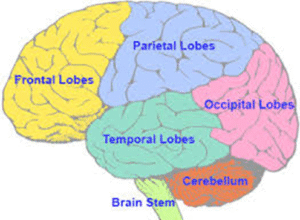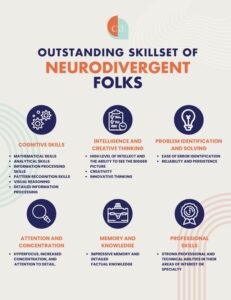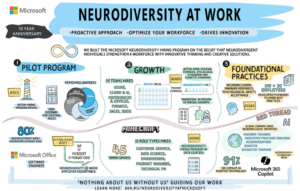
What is Neurodiversity – and Why Does It Matter?

Introduction
Imagine a world where everyone’s brain comes with a unique blueprint. Where learning, thinking, processing information don’t follow one standard mould — but many. That’s the world the concept of neurodiversity invites us to consider.
For the audience of The Neuro Spectrum Coach — learners, educators, professionals and individuals exploring how they can fit into society with their full spectrum of neuro-ways — understanding this concept matters. Because it changes the question: instead of “What’s wrong with me?” we ask “How does my brain fit — and how does the world need to adapt?”
What is Neurodiversity?
The term “neurodiversity” describes the natural variation in how human brains work: in how we think, learn, communicate, sense, and experience the world. According to National Autistic Society (UK):
“Neurodiversity is a way of saying everyone’s brain is different to each other. … Neurodiversity includes every single human being.” (National Autistic Society)
Another UK source explains:
“Neurodiversity describes the natural differences in how people’s brains behave and process information. … We all think, learn and act differently; we all have different strengths and things we find challenging.” (Acas)


So: neurodiversity isn’t a label for a specific condition — it’s the umbrella concept that covers the full range of neurological difference. Think of it like biodiversity in biology: many different kinds of brain-wiring, each valid in its own right.
The distinction is subtle but meaningful: unlike “neurotypical vs neurodivergent” (which refer to people with more common/neurotypical processing versus different-wiring brains), “neurodiversity” places variation at the centre rather than framing people as “other”.
Conditions and Differences Included

Under the neurodiversity umbrella we often include several well-recognised conditions and differences:
- Autism Spectrum Disorder (ASD)
- Attention Deficit/Hyperactivity Disorder (ADHD)
- Dyslexia (reading/writing processing differences)
- Dyspraxia (coordination/movement challenges)
- Dyscalculia (numbers/logic processing differences)
… and other neurodevelopmental conditions. For example, UK government guidance states:
“Neurodiversity … encompasses neurological differences, such as those seen in the group of conditions that fall under the broad category of neurodevelopmental disorders, as well as those present as a result of acquired brain injury.” (GOV.UK)
It’s important to emphasise: having one of these conditions doesn’t define the whole person. And many people may have overlapping (co-occurring) differences — for example ADHD and dyslexia. Academic research on thinking patterns (e.g., visual versus verbal, novel-problem vs acquired-knowledge) shows wide variation even within diagnostic categories. (Embracing Intensity)
Why Neurodiversity Matters
Here are a few reasons why this concept holds real-world weight.
- Inclusion & Belonging
If society expects one particular way of thinking/learning/processing to be “normal”, those whose brains work differently may feel excluded, misunderstood or undervalued. Recognising neurodiversity shifts the mindset: different ≠ wrong. It opens the doorway to belonging.
- Strengths-oriented view
In traditional models we often focus on what doesn’t work. The neurodiversity paradigm emphasises what does work — the unique strengths linked to atypical brain-wiring. For example, some learners may exhibit strong pattern-recognition, intense focus, creative thinking, or visual thinking styles. (Tiimo)
- Systems change (not just individual change)
It isn’t enough to help an individual adapt to a standard environment. We need to ask: how can the environment adapt to the person? Learning spaces, workplaces, public services all benefit when designed with variation in mind.
- Better outcomes for all
When learning or working systems are flexible, many people—not just those labelled as neurodivergent—benefit: clearer communication, alternate ways of demonstrating learning, accommodations for processing differences. Government policy summarises that children and young people who are neurodivergent often have poorer outcomes if supports are delayed or missing. (Parliament Research Briefings)
How to Understand Neurodiversity in Practice


Let’s ground the concept in everyday life.
Self-understanding & identity
If you’re exploring your own brain-style (or supporting others):
- Recognise that thinking/learning differently doesn’t mean “worse”.
- Realising you have a brain-style outside the majority norm can bring clarity, relief, and a reframing of self.
Environment & adjustment
- In educational settings: offer alternative ways to learn and express (visual supports, written and spoken formats, extra processing time, sensory-considerate spaces).
- In workplaces: adjust communication methods (email vs only meetings), allow flexible working styles, support disclosure/adjustments, value difference.
- In public / services: create accessible design (clear language, predictable routines, sensory-friendly options).
Recognising overlap & variation
Neurodiversity is not tidy. A person might not have a formal diagnosis yet still have a brain-style that differs. Some differences might show more in certain contexts (school vs work vs home). Some people mask their brain-style to “fit in”, which leads to fatigue and stress. (National Autistic Society)
Common Questions & Challenges
Q: Is neurodiversity the same as disability?
Not quite. Neurodiversity describes variation. Whether a person is “disabled” in a given context depends on how their brain-style interacts with the environment (barriers vs supports). UK law (e.g., Equality Act 2010) protects individuals whose differences meet certain criteria. (Parliament Research Briefings)
Q: If I’m neurodivergent, does that mean I’ll always struggle?
No. It means you may have different ways of thinking/processing. Some tasks might be harder, others might come more easily or in unique ways. The key is understanding what helps you thrive.
Q: Do I need a diagnosis to be valid or to access support?
No. While a diagnosis can open certain pathways to support, many systems emphasise need and adjustment rather than diagnosis alone. For example, in UK education the SEND system supports children with “special educational needs” whether or not there’s a formal label. (Parliament Research Briefings)
Q: Are there risks in using the term “neurodiversity”?
Yes — good to note.
- The term can be over-used or mis-applied (“token neurodiversity”) without real change.
- Some individuals may feel that emphasis on “difference” downplays the real world barriers they face (sensory overload, mental health, exclusion). So it’s vital to keep the complexity in view.
Why It Matters for You (Learners, Coaches, Professionals)
- Learners: Understanding neurodiversity helps you see that your brain-style is not a flaw, but a variation. With that awareness you can advocate for what will support you, access strategies aligned with your way of processing, and connect with others whose minds work differently.
Educators/Coaches: Embracing neurodiversity means designing for many ways of thinking and learning — not forcing one path. It means seeing difference as value, not just challenge
Workplaces & society: When systems adapt rather than assume one brain-type, we uncover untapped talent, greater innovation, more equitable inclusion. This matters for culture,

What Good Inclusion Looks Like

Here are some practical hallmarks of inclusive environments:
- Language: Use respectful, person-centred language. Avoid implying “less than”. The National Autistic Society emphasises how language shapes identity. (National Autistic Society)
- Flexible solutions: Offer multiple ways to learn, to report, to communicate. One size doesn’t fit all.
- Sensory & processing awareness: Recognise that sensory load, processing speed, transitions may present obstacles. Adapt environments accordingly.
- Strength-based mindset: Instead of “what’s wrong”, ask “what’s going well, how can we build on that?”
- Culture of belonging: True inclusion isn’t just accommodations—it’s about belonging, feeling valued, safe to disclose if one wants to, and being accepted for who one is.
- Review & evolve: Inclusion isn’t static. Ask neurodivergent people what works, iterate, adapt, learn.
Final Thoughts
Neurodiversity matters because it invites us to recognise that there is no one “right” brain. When we stop expecting conformity in thinking, learning and doing, we open up possibility: for every individual and for society.
For your work at The Neuro Spectrum Coach this is powerful: helping people see how their mind works, understand how the world interacts with their wiring, and advocate for the environments and supports that help them thrive.
When brains vary and we design for variation, we all benefit.
Suggested Further Reading & Resources
- National Autistic Society: “What is neurodiversity?” (National Autistic Society)
- UK Government: “Neurodiversity Guidance” (2024) (UK)
- Research briefing: “Support for neurodivergent children and young people” (2024) (Parliament Research Briefings)

